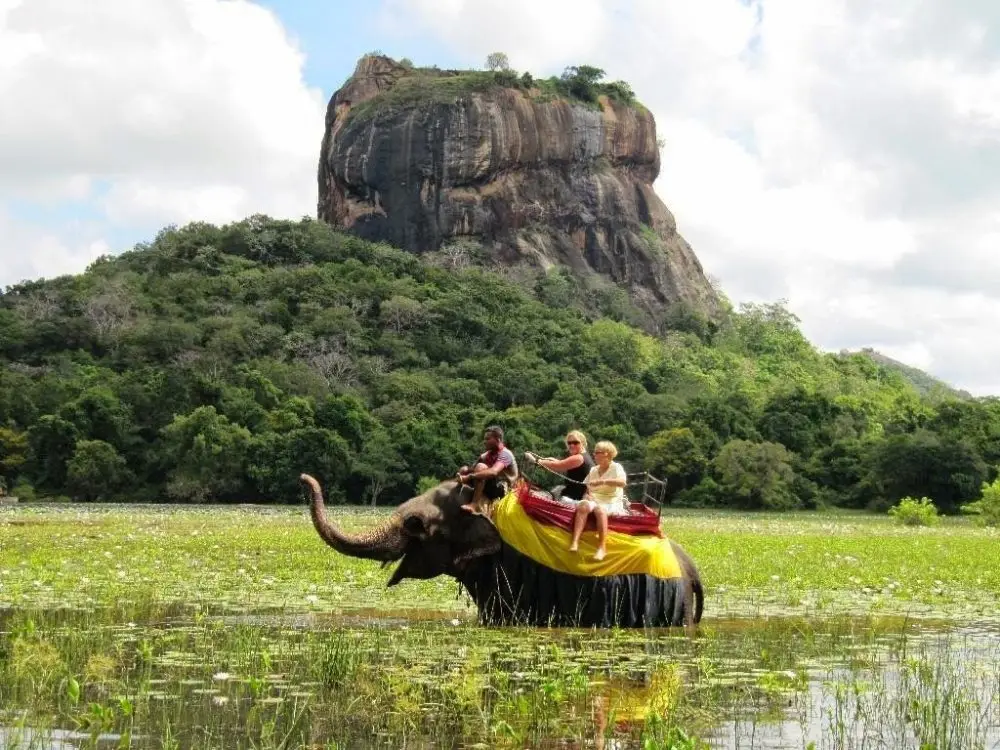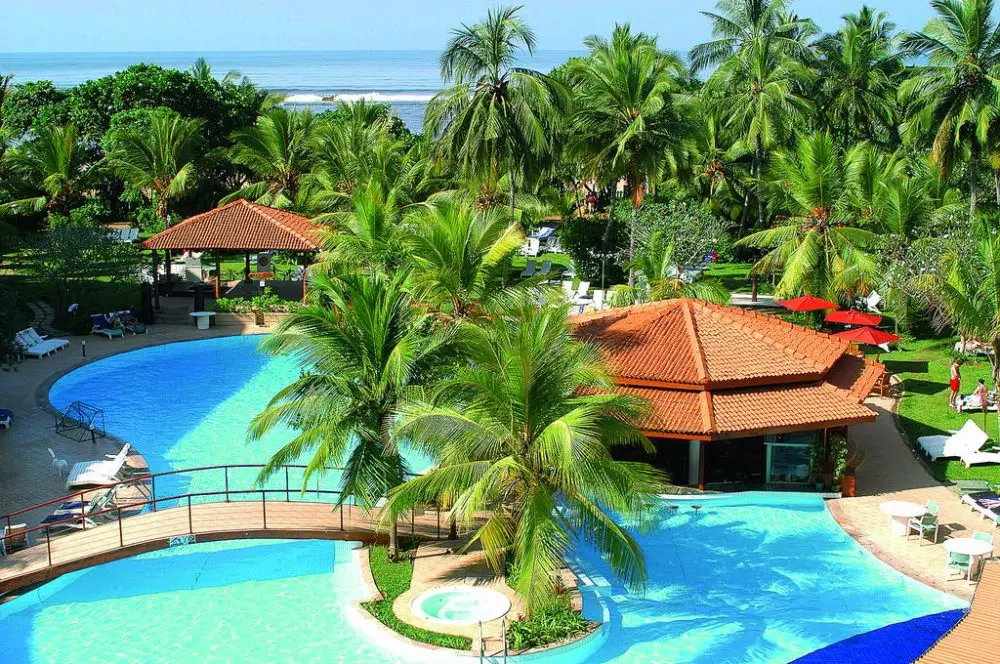When planning a trip to South Asia, it is worth paying attention to the most beautiful places in Sri Lanka — a country that combines ancient history, nature, culture, and oceanic landscape. The island in the Indian Ocean offers unique landscapes: mountain peaks, tea plantations, waterfalls, tropical forests, and ancient cities.
Unlike mass tourist destinations, Sri Lanka reveals itself gradually to the traveler, offering a rich itinerary and an authentic experience. The route covers key attractions of Sri Lanka, creating a rich and memorable vacation.

Sigiriya — ancient fortress on top of a rock
The symbol of the country — Sigiriya, located on top of a basalt rock about 200 meters high. Former palace and fortress of King Kassapa, and today a monument included in the UNESCO World Heritage List. Climbing the stone stairs offers a panoramic view of the jungle and tea plantations.
Frescoes carved into the rock and the architecture of the complex make Sigiriya a must-visit on the route to the beautiful places of Sri Lanka. Local guides talk about the water supply system, ancient canals, and the significance of lion’s paws carved at the foot of the rock.
Dambulla Temples — center of culture and faith
The next stop is Dambulla, known for its cave temples where unique frescoes and statues have been preserved. Five cave halls contain over 150 images of Buddha, including a sculpture over 14 meters long. The uniqueness lies in the harmonious combination of architecture and the natural form of the rock.
The temple complex reflects the island’s centuries-old history and culture, allowing visitors to touch the spiritual side of Sri Lanka. Visiting Dambulla complements the perception of the most beautiful places in Sri Lanka not only visually but also emotionally.
Ella — mountain resort overlooking tea hills
The highland area of Ella is known as the center of active recreation in Sri Lanka. Located among hills, the town is surrounded by tea plantations, waterfalls, and green slopes.
Here you can climb Little Adam’s Peak, see the Nine Arch Bridge, and visit viewpoints offering picturesque landscapes. Ella is perfect for walks, trekking, and getting to know local life. The culture of tea production is felt literally in every home — tourists are offered tours of factories and tastings.
Galle — ancient fort by the ocean
The city of Galle combines colonial architecture, cozy streets, and a majestic fort built by the Portuguese and fortified by the Dutch. Stone walls, a lighthouse, and church buildings harmoniously blend into the coastal landscape.
The city of Galle, surrounded by ancient forts and colonial architecture, becomes a must-visit on the route for those seeking to explore different facets of the island. It is no coincidence that it is included in the list of the most beautiful places in Sri Lanka, combining historical depth, aesthetic appeal, and a unique atmosphere.
Nuwara Eliya Tea Plantations
The city of Nuwara Eliya is often called “Little England” due to its mild climate, Gothic architecture, and green spaces. Here are located the largest tea plantations that export their products worldwide.
A walk among the plantations is a way to experience the slow pace of life, appreciate the work of tea pickers, and learn how the leaf turns into a ready-to-drink beverage. It is here that relaxation on the island takes on a special format: silence, fresh air, mountain peaks, and the aroma of tea create ideal conditions for rejuvenation.
Ravana Waterfall and mountain trekking
One of the picturesque natural attractions is the Ravana Waterfall, located near Ella. The water flows down cascading cliffs surrounded by forest and rocks. Travelers often stop here on their way to the mountainous regions.
The landscape of the waterfall and nearby gorges symbolizes wild nature, making the place an important part of the route to the most beautiful places in Sri Lanka. Nearby, mountain climbing routes begin, accessible even to beginners.
What to see in Sri Lanka: the most beautiful places beyond the route
As part of a rich itinerary in Sri Lanka, it is worth paying attention to less obvious but no less expressive locations:
- Peradeniya Botanical Garden — the largest garden on the island, where rare plants and trees from around the world are collected. Palm alleys, orchid pavilions, and ponds make the park an ideal place to relax;
- Nine Arch Bridge — an engineering structure from the colonial period, surrounded by hills and forests. A train regularly passes over it, creating unforgettable scenes;
- Mihintale — an ancient mountain where Buddhism originated in Sri Lanka. A staircase of 1800 steps leads to temples, statues, and viewpoints;
- Anuradhapura Bodhi Tree — a sacred tree and one of the oldest places of worship on the island. The atmosphere of silence and holiness emphasizes the cultural significance of the location.
These places allow you to delve deeper into tourism in its cultural and natural components.
When to travel to Sri Lanka?
The climate on the island is divided into two main zones: the southwest coast and the central mountainous regions are influenced by the southwest monsoon from May to September, while the northeast is subject to rainfall from October to February.
The optimal time to visit the most beautiful places in Sri Lanka is considered to be from December to March — during this period, the weather remains stable over most of the territory, and the landscapes are particularly expressive.
During the off-season, despite the possibility of brief showers, traveling around the island remains comfortable, especially in the central regions. Flexible route planning allows adaptation to weather conditions and ensures not to miss important attractions.
Transport and logistics on the route
Transfers between locations in Sri Lanka require time and careful logistics. Railway routes, such as the line from Kandy to Ella, are not only practical but also picturesque. Buses are the most accessible but not always comfortable way of transportation.
A car with a driver remains the most comfortable option, especially for those visiting attractions within a tight schedule. In some areas, it is possible to rent motorbikes, but considering local road conditions and traffic peculiarities, this format is not suitable for everyone.

Conclusion
The most beautiful places in Sri Lanka are not only picturesque locations but also embodiments of history, nature, and culture. From tea plantations to mountain temples, from waterfalls to seaside forts — every corner of the island offers a unique experience.
Traveling through Asia encompasses visual perception, cultural enrichment, and vacation surrounded by greenery, rocks, and temples. A well-thought-out route allows for a rich and balanced vacation in Sri Lanka!
 en
en  ru
ru  de
de  nl
nl  ar
ar  es
es  fr
fr  hi
hi  it
it  pt
pt  el
el 










